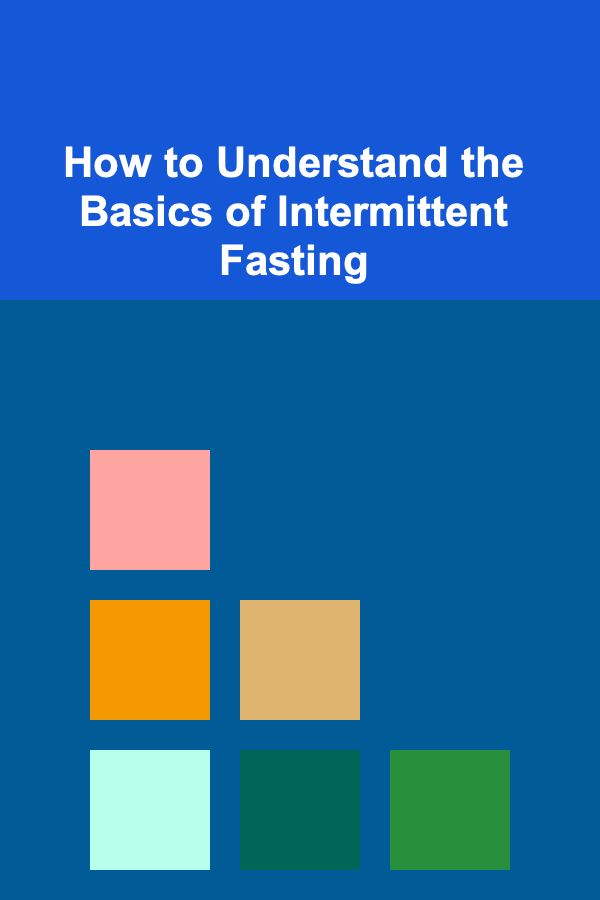
How to Understand the Basics of Intermittent Fasting
ebook include PDF & Audio bundle (Micro Guide)
$12.99$6.99
Limited Time Offer! Order within the next:

Intermittent fasting (IF) has become a widely popular approach to dieting and weight management, praised for its simplicity and effectiveness. Unlike traditional diets that focus on what foods to eat, intermittent fasting emphasizes when to eat. This approach involves alternating between periods of eating and fasting, offering numerous health benefits when done correctly. However, understanding the basics of intermittent fasting is essential before diving into this practice, as it may not be suitable for everyone. In this article, we will explore what intermittent fasting is, how it works, the different methods of intermittent fasting, and the science behind its health benefits.
What is Intermittent Fasting?
Intermittent fasting refers to an eating pattern that cycles between periods of fasting (not eating) and eating. It is not a traditional diet in the sense that it doesn't restrict specific foods but focuses on when to consume meals. The primary goal of intermittent fasting is to allow the body to enter a fasting state, where it can burn fat for energy and promote cellular repair.
During a fasting period, individuals abstain from consuming food, although drinking water, herbal teas, or black coffee is typically allowed. The fasting window can last anywhere from 12 hours to 24 hours or more, depending on the specific method chosen. The eating period is when food is consumed, and the length of the eating window can also vary.
The appeal of intermittent fasting lies in its flexibility and the fact that it doesn't require individuals to count calories or limit their food choices. Instead, the timing of meals and the periods of fasting are the focus.
The Science Behind Intermittent Fasting
Intermittent fasting works by utilizing the body's natural processes, which are activated during periods of fasting. When you eat, your body is in a "fed" state, using the energy from food for immediate use. After several hours without food, your body transitions into a "fasted" state. This shift allows the body to tap into stored energy, primarily in the form of fat, to fuel essential processes.
In this fasted state, several beneficial biological processes are triggered, including:
- Improved Insulin Sensitivity: When you eat, insulin levels rise to help store glucose (sugar) from the bloodstream into cells. Fasting helps reduce insulin levels and improve insulin sensitivity, which can aid in better blood sugar control. This is particularly beneficial for individuals with or at risk for type 2 diabetes.
- Fat Burning: During fasting, the body uses fat as its primary energy source. The process of burning fat for energy is called lipolysis. As insulin levels decrease, the body's ability to burn stored fat improves, which can lead to weight loss over time.
- Cellular Repair and Autophagy: Fasting triggers a process called autophagy, where cells begin to remove damaged components, repair themselves, and recycle waste products. This process is thought to play a role in aging and disease prevention.
- Hormonal Changes: Fasting causes several hormonal changes, including increased production of human growth hormone (HGH), which promotes fat loss and muscle gain. Additionally, fasting increases norepinephrine, a hormone that enhances fat burning.
- Improved Metabolic Health: Intermittent fasting can improve various metabolic markers, including cholesterol levels, triglycerides, and blood pressure, leading to better overall health and a reduced risk of cardiovascular diseases.
Common Methods of Intermittent Fasting
There are several popular methods of intermittent fasting, each varying in duration and frequency of fasting periods. Some methods are more suitable for beginners, while others may be better for individuals with experience in fasting. Here are some of the most common methods:
1. The 16/8 Method (Leangains Protocol)
One of the most popular and beginner-friendly approaches to intermittent fasting is the 16/8 method, also known as the Leangains protocol. In this method, individuals fast for 16 hours and eat within an 8-hour window. For example, one might eat between 12:00 PM and 8:00 PM, fasting from 8:00 PM to 12:00 PM the next day.
This method is simple to follow and does not require drastic changes to eating habits. It is often used by people who want to lose weight, improve insulin sensitivity, and maintain muscle mass.
2. The 5:2 Diet
The 5:2 diet, also known as the Fast Diet, involves eating normally for five days of the week and severely restricting calories (about 500--600 calories) for the other two days. On fasting days, the calorie intake is significantly reduced, but not entirely eliminated. This method is flexible and allows individuals to choose which two days of the week they wish to fast.
This approach can be easier to follow for those who find it challenging to fast for long periods. It also provides the benefits of fasting while allowing individuals to eat regularly for the majority of the week.
3. The Eat-Stop-Eat Method
The Eat-Stop-Eat method involves fasting for a full 24 hours once or twice a week. This means refraining from eating from dinner one day to dinner the next day, for example. While fasting, only water, tea, or black coffee are allowed.
This method can be more difficult for beginners due to the longer fasting period, but it is effective for promoting fat loss and improving metabolic health.
4. Alternate-Day Fasting
Alternate-day fasting involves alternating between fasting days and regular eating days. On fasting days, individuals either consume very few calories (around 500) or none at all. On eating days, individuals can eat normally.
While alternate-day fasting can be effective for weight loss, it can be challenging for some people to maintain over the long term due to the strict fasting schedule.
5. The Warrior Diet
The Warrior Diet is a more extreme form of intermittent fasting, where individuals eat one large meal at night after fasting for 20 hours. During the fasting period, individuals are encouraged to consume small amounts of raw fruits and vegetables, as well as non-caloric beverages like water and herbal tea.
This method is not suitable for beginners and may be difficult to sustain over time due to its restrictive nature.
Health Benefits of Intermittent Fasting
Intermittent fasting offers a variety of health benefits, some of which are still being explored through scientific research. Below are some of the most well-established benefits:
1. Weight Loss and Fat Loss
Intermittent fasting is widely used as an effective weight loss strategy. By limiting the eating window and fasting for extended periods, individuals naturally reduce their calorie intake, which leads to weight loss. Additionally, fasting helps increase metabolic rate and fat burning by reducing insulin levels and increasing norepinephrine levels, which boost fat mobilization.
2. Improved Insulin Sensitivity
As mentioned earlier, intermittent fasting improves insulin sensitivity, which helps regulate blood sugar levels. This can be particularly beneficial for individuals at risk of type 2 diabetes. Improved insulin sensitivity reduces the need for the body to produce excess insulin, thus lowering the risk of insulin resistance.
3. Enhanced Brain Health
Intermittent fasting has been shown to promote brain health by increasing the production of brain-derived neurotrophic factor (BDNF), a protein that supports brain function and the growth of new neurons. Fasting may also improve cognitive function, increase mental clarity, and protect against neurodegenerative diseases like Alzheimer's and Parkinson's.
4. Reduced Inflammation
Inflammation is a contributing factor in many chronic diseases, including heart disease, diabetes, and cancer. Studies suggest that intermittent fasting can reduce inflammation markers in the body, contributing to improved overall health.
5. Longevity
Some animal studies have shown that intermittent fasting can extend lifespan by promoting cellular repair processes like autophagy and reducing oxidative stress. While more research is needed to determine the effects of intermittent fasting on human longevity, the evidence is promising.
6. Heart Health
Intermittent fasting can improve heart health by reducing risk factors such as high blood pressure, cholesterol levels, triglycerides, and inflammatory markers. These improvements can reduce the risk of heart disease and stroke over time.
Considerations and Potential Risks
While intermittent fasting can provide numerous health benefits, it is not suitable for everyone. It is important to consult with a healthcare professional before starting any fasting regimen, particularly if you have underlying health conditions such as diabetes, eating disorders, or heart problems.
Some potential risks and considerations include:
- Nutrient Deficiency: If fasting periods are too long or calorie intake is severely restricted, individuals may not consume enough essential nutrients, leading to deficiencies.
- Overeating During Eating Windows: Some individuals may overeat during the eating window, which can negate the benefits of fasting and lead to weight gain.
- Hormonal Imbalance: Fasting can affect hormones, particularly in women, where long-term fasting may disrupt menstrual cycles or lead to reproductive health issues.
Conclusion
Intermittent fasting is a flexible and effective approach to improving overall health, aiding in weight loss, and enhancing metabolic function. By understanding the basics of intermittent fasting, including the different methods and their associated benefits, individuals can make informed decisions about whether this approach is right for them. While intermittent fasting offers many health benefits, it is essential to approach it mindfully, ensuring that it is practiced in a balanced and sustainable manner for long-term success.

How to Save Money on Home Decor and Still Achieve a Stylish Look
Read More
How to Use LinkedIn Articles to Position Your B2B Dropshipping Business as an Authority
Read More
How To Discover the Palace of Knossos
Read More
How to Build a Passive Solar Home
Read More
The Art and Science of Steaming Fish and Vegetables
Read More
How to Create Sewing Patterns from Existing Clothes
Read MoreOther Products

How to Save Money on Home Decor and Still Achieve a Stylish Look
Read More
How to Use LinkedIn Articles to Position Your B2B Dropshipping Business as an Authority
Read More
How To Discover the Palace of Knossos
Read More
How to Build a Passive Solar Home
Read More
The Art and Science of Steaming Fish and Vegetables
Read More